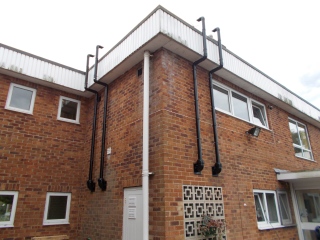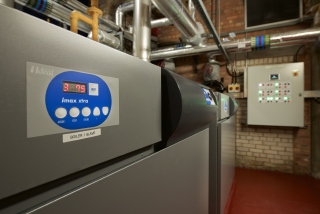The ErP effect on boiler replacement work

Andrew Dabin of Ideal Commercial Boilers, reflects on the challenges facing building-services engineers who are undertaking boiler retrofit projects post-ErP and how manufacturers can help uncover solutions that will minimise capital outlay whilst delivering a high-efficiency heating system.
It has now been over three months since the second stage of the Energy-related Products (ErP) Directive came into implementation, and all members of the supply chain are seeing its effects. The reasons for the creation and implementation of the ErP Directive are clear — to reduce energy consumption, minimise carbon emissions and improve energy security.
Although it is important to understand the reasons behind the legislation, ultimately its success is reliant on the daily decisions made by engineers and manufacturers out in the field and how they overcome the challenges they face.
One of the major concerns that manufacturers are hearing from specifiers and building-services engineers relates to multiple-boiler installations where one of the boilers has come to the end of its life. In the past, the failing appliance would almost always be replaced with a like-for-like model, with little or no changes to the heating system.
For this reason, engineers will typically arrive at an older plant room to find several boilers in a line, some of which will have been running for years, some that have been replaced and one that has failed recently — hence the current replacement works. In a post-ErP world, though, replacement of the failed boiler with a standard-efficiency alternative is no longer an option for boilers of 400 kW and below.
Many engineers are concerned that the only option is to replace all existing boilers with condensing versions. There are, however, long-term advantages to retrofitting boilers with condensing alternatives, as running costs and emissions will be significantly reduced. The issue is that the capital outlay may be a struggle for businesses that have not set funds aside for these eventualities.
 |
| Flues can prove a challenge when not all boilers are replaced in a plant room with several boilers. |
Fortunately there are solutions that will enable engineers to replace a single failed non-condensing unit with a condensing boiler, even when installed in-line with other standard efficiency boilers, thereby avoiding the need for total boiler house replacement. What is required is an in-depth understanding of the implications involved.
One of the issues to look at when installing a condensing boiler alongside older boilers is whether the heat exchanger will need to be protected. Heating systems are dosed with chemical additives to protect pipework and components against corrosion, and the type and level of chemicals used will be dependent on the material of the boiler’s heat exchanger. A non-condensing boiler will usually have a cast-iron heat exchanger, whereas condensing boilers will usually have either a stainless steel or an aluminium heat exchanger. However, the same dosing chemicals are not compatible with these materials, so system separation will need to be achieved via a plate heat exchanger. This will also prevent the new boiler from becoming contaminated with sludge and debris that could be circulating in the old boiler pipework system and, in addition, will allow for any design differences on the original system that may have been utilised using different flow and return temperatures.
The correct specification of plate heat exchanger would be recommended by the manufacturer, and it would then need to be fitted to the new condensing boiler before being connected to the existing system. If all boilers are replaced at once, just one plate heat exchanger would be required for all boilers in the system. Alternatively, if each boiler is replaced individually, the engineer will need to ensure that a new plate heat exchanger is fitted to each new boiler as it is installed.
Flues provide another challenge. Condensing-boiler flues are more costly than regular flues as the grade of stainless steel needs to be higher to withstand the corrosive nature of condensate. One solution when conducting a condensing-boiler retrofit is to cap off the existing flue, ensuring that the system installed satisfies the existing boilers left running, and link the boiler to a new single condensing flue which will then require its own termination point outside the building. This could possibly be run upwards and terminated through the roof, allowing similar modifications to be made if and when other boilers in the line are replaced, as well as minimising the length of condensing flue needed for the individual project.
 |
| Imagination can be needed when new boilers are mixed with existing boilers in a plant room. |
In instances where the entire boiler flue system can be replaced but where multiple termination points are either undesired or impossible, leading manufacturers can offer a multi-line flue cascade accessory for wall-hung condensing boiler installations up to 600 kW. These enable the boilers to be installed as an open-flue system and connected via a common flue header, creating a single connection point that is recognised by flue specialists.
Yet another consideration is that the new flue may be smaller in diameter so, depending on the application, the condensing flue could be run inside an existing flue, making use of the existing termination point to minimise the work required.
Provision will also need to be given to any condensate removal that will be generated by the new boiler, so route termination will need to be worked out, and a condensate pump may be required.
These considerations have merely touched the surface of the issues engineers and building owners are facing since the ErP Directive was implemented.
However, for every challenge there is a solution.
The key is to involve manufacturers, who are the product experts, at an early stage and throughout a project so they can troubleshoot to prevent issues arising. This will ensure that each installation results in an efficient heating system that is compliant with the new legislation, whilst minimising cost and inconvenience to the end user.
Andrew Dabin is product manager for Ideal Commercial Boilers.







